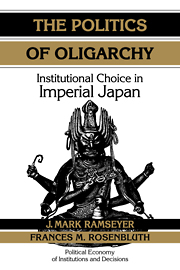Book contents
- Frontmatter
- Contents
- List of tables and figure
- Series editors' preface
- Acknowledgments
- CHAPTER 1 INTRODUCTION
- CHAPTER 2 THE COLLAPSE OF OLIGARCHY: FAILED ATTEMPTS AT CARTEL-MAINTENANCE
- CHAPTER 3 CONCESSION OR FACADE: THE MEIJI CONSTITUTION
- CHAPTER 4 ELECTORAL RULES AND PARTY COMPETITION: THE STRUGGLE FOR POLITICAL SURVIVAL
- CHAPTER 5 THE BUREAUCRACY: WHO RULED WHOM?
- CHAPTER 6 THE COURTS: WHO MONITORED WHOM?
- CHAPTER 7 THE MILITARY: MASTER OF ITS OWN FATE
- CHAPTER 8 FINANCIAL POLITICS
- CHAPTER 9 RAILROAD POLITICS
- CHAPTER 10 COTTON POLITICS
- CHAPTER 11 CONCLUSION: INSTITUTIONS AND POLITICAL CONTROL
- Notes
- References
- Index
CHAPTER 9 - RAILROAD POLITICS
Published online by Cambridge University Press: 05 June 2012
- Frontmatter
- Contents
- List of tables and figure
- Series editors' preface
- Acknowledgments
- CHAPTER 1 INTRODUCTION
- CHAPTER 2 THE COLLAPSE OF OLIGARCHY: FAILED ATTEMPTS AT CARTEL-MAINTENANCE
- CHAPTER 3 CONCESSION OR FACADE: THE MEIJI CONSTITUTION
- CHAPTER 4 ELECTORAL RULES AND PARTY COMPETITION: THE STRUGGLE FOR POLITICAL SURVIVAL
- CHAPTER 5 THE BUREAUCRACY: WHO RULED WHOM?
- CHAPTER 6 THE COURTS: WHO MONITORED WHOM?
- CHAPTER 7 THE MILITARY: MASTER OF ITS OWN FATE
- CHAPTER 8 FINANCIAL POLITICS
- CHAPTER 9 RAILROAD POLITICS
- CHAPTER 10 COTTON POLITICS
- CHAPTER 11 CONCLUSION: INSTITUTIONS AND POLITICAL CONTROL
- Notes
- References
- Index
Summary
INTRODUCTION
Trains are different from other investments. Basic to our enterprise here, they differ in the significance historians attach to them. For decades, scholars routinely thought them the revolutionary technological change of the nineteenth century.
Trains also differ in their externalities. For decades, scholars routinely argued that they created a wide variety of beneficial spillovers. They generated larger labor markets, smoother national defense strategies, and broader trade patterns. Because railroad shareholders could not capture all these spillovers, scholars argued, left alone they invested suboptimally. Hence a role for government: Perhaps, if it subsidized the industry, it could induce more efficient investment patterns.
Trains differ too in the coordination problems they generate. Not only must firms match their competitors' track gauges and negotiate ways to handle shippers who send freight across more than one railroad. They must overcome special problems in buying the land they will use. Because they need contiguous parcels, sellers (if they know a railroad's plans) can hold up a firm for enormous prices. Hence the other role for government: Perhaps, by easing these hold-up problems, it could alleviate transactions costs too.
These claims are not specific to a particular country. Scholars do not just make them of the United States and Europe. They routinely make them of Japan as well. In his survey of the Japanese economy, Takatoshi Ito (1992: 20, 29) lists railroads prominently among Japan's infrastiructural investments. He then finds in the way the government promoted them a “key to Japan's fast economic growth.”
- Type
- Chapter
- Information
- The Politics of OligarchyInstitutional Choice in Imperial Japan, pp. 118 - 134Publisher: Cambridge University PressPrint publication year: 1995
- 1
- Cited by



